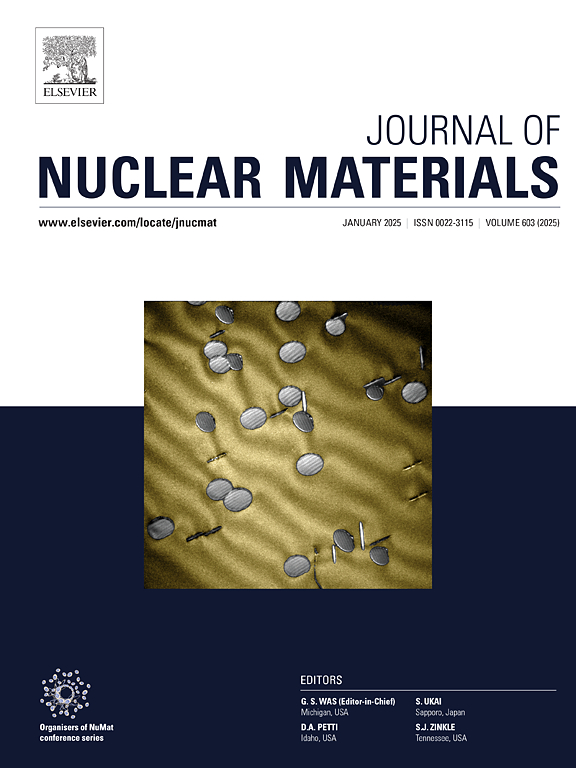Heat-treated additively manufactured and wrought 316L steels display a comparable response to ion irradiation
IF 2.8
2区 工程技术
Q3 MATERIALS SCIENCE, MULTIDISCIPLINARY
引用次数: 0
Abstract
Additive manufacturing produces metallic components with inhomogeneous microstructures. This inhomogeneity can negatively impact mechanical properties and in-service performance. Applying post-printing heat treatments can reduce microstructural inhomogeneity but a validation of alloy performance, under specific operational environments is still required.
316L stainless steels are used for a variety of components in nuclear power plants. They are exposed to irradiation at elevated temperature during service, which alters the microstructure and mechanical properties. To validate the implementation of additively manufactured 316L components in environments where they are exposed to irradiation, it is necessary to ensure that additively manufactured components will display comparable behaviour under irradiation to their wrought counterparts.
In this study we use atom probe tomography, transmission electron microscopy, and nanoindentation to investigate the response of additively manufactured 316L alloys, produced by laser powder bed fusion, exposed to ion irradiation. Our results, when compared to published data on wrought 316L alloys, demonstrate that performing post-printing heat treatments at 1066 °C and 1150 °C leads to 316L alloys that display a comparable response to ion irradiation when compared to conventionally manufactured 316L specimens.
热处理增材制造和变形的316L钢对离子辐照表现出类似的响应
增材制造生产的金属部件具有不均匀的微观结构。这种不均匀性会对机械性能和使用性能产生负面影响。采用印后热处理可以减少微观组织的不均匀性,但仍需要在特定的操作环境下验证合金的性能。316L不锈钢用于核电厂的各种部件。它们在使用过程中受到高温辐照,从而改变了微观结构和力学性能。为了验证增材制造的316L组件在暴露于辐照环境中的实施情况,有必要确保增材制造的组件在辐照下表现出与锻造组件相当的行为。在这项研究中,我们使用原子探针断层扫描、透射电子显微镜和纳米压痕来研究激光粉末床熔合生产的增材制造316L合金在离子照射下的反应。与已发表的316L合金锻造数据相比,我们的研究结果表明,在1066°C和1150°C下进行印刷后热处理,316L合金对离子辐照的反应与传统制造的316L合金样品相比具有相当的反应。
本文章由计算机程序翻译,如有差异,请以英文原文为准。
求助全文
约1分钟内获得全文
求助全文
来源期刊

Journal of Nuclear Materials
工程技术-材料科学:综合
CiteScore
5.70
自引率
25.80%
发文量
601
审稿时长
63 days
期刊介绍:
The Journal of Nuclear Materials publishes high quality papers in materials research for nuclear applications, primarily fission reactors, fusion reactors, and similar environments including radiation areas of charged particle accelerators. Both original research and critical review papers covering experimental, theoretical, and computational aspects of either fundamental or applied nature are welcome.
The breadth of the field is such that a wide range of processes and properties in the field of materials science and engineering is of interest to the readership, spanning atom-scale processes, microstructures, thermodynamics, mechanical properties, physical properties, and corrosion, for example.
Topics covered by JNM
Fission reactor materials, including fuels, cladding, core structures, pressure vessels, coolant interactions with materials, moderator and control components, fission product behavior.
Materials aspects of the entire fuel cycle.
Materials aspects of the actinides and their compounds.
Performance of nuclear waste materials; materials aspects of the immobilization of wastes.
Fusion reactor materials, including first walls, blankets, insulators and magnets.
Neutron and charged particle radiation effects in materials, including defects, transmutations, microstructures, phase changes and macroscopic properties.
Interaction of plasmas, ion beams, electron beams and electromagnetic radiation with materials relevant to nuclear systems.
 求助内容:
求助内容: 应助结果提醒方式:
应助结果提醒方式:


